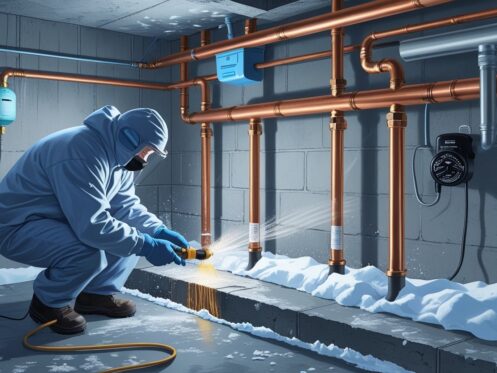Frozen water pipes can be a frustrating problem, especially during the colder months. To effectively thaw frozen pipes, apply gentle heat to the affected area using methods like a heating pad or hair dryer, while ensuring the faucet is open to allow melting water to escape. Taking quick action can prevent serious damage and costly repairs.
If you find yourself dealing with this issue, it’s essential to know the best approaches. For instance, you might consider wrapping the pipe with an electric heating pad or using towels soaked in hot water. At Splash Plumbing, we understand the urgency of such situations and are here to assist you with our expert plumbing services.
Don’t let frozen pipes disrupt your home. With the right techniques, you can restore water flow smoothly and safely. If you need help or prefer a professional to handle the situation, Splash Plumbing is ready to provide reliable solutions in Anaheim, CA, ensuring your plumbing systems work efficiently again.
Understanding Frozen Pipes and Their Risks
When the temperature drops, pipes can freeze, leading to significant plumbing issues. Recognizing the causes, signs, and potential dangers of frozen pipes helps you take action quickly to prevent water damage.
What Causes Pipes to Freeze
Pipes are most vulnerable to freezing when outdoor temperatures fall below 20°F. Common causes include inadequate insulation, particularly in unheated areas like basements and attics. Pipes running along exterior walls are also at risk. Additionally, reduced water flow due to shut-off valves being closed or low water pressure can contribute to freezing. When water within pipes freezes, it expands, creating pressure that can lead to ruptured pipes. If you suspect your pipes are freezing, addressing them quickly is critical to prevent further issues and costly repairs.
Signs Your Pipes Are Frozen
Identifying frozen pipes early can save you from extensive damage. If you notice that water doesn’t flow from your taps when turned on, it’s a strong indicator. Additionally, frozen pipes may cause unusual sounds like banging or gurgling as pressure builds up. If specific areas of your home experience a cold draft or feel unusually cold, that may be due to frozen plumbing. Visible frost on the exterior of pipes or cracks can also signal freezing. Keep an eye out for any signs of leaks, as they can indicate that a pipe has burst due to pressure from freezing.
Potential Dangers of Frozen and Burst Pipes
The most significant risk with frozen pipes is the potential for water damage caused by a burst pipe. When a pipe bursts, it can unleash a large volume of water into your home, damaging walls, floors, and personal belongings. This can lead to mold growth, important structural issues, and costly repairs. Additionally, sudden fluctuations in water pressure from a burst pipe can damage your entire plumbing system. Regular maintenance and proper insulation can mitigate these risks. If you experience any indicators of frozen pipes, consider contacting professionals like Splash Plumbing for timely assistance to avoid long-term issues.
Immediate Steps to Take When Pipes Freeze
When your water pipes freeze, taking prompt action is crucial to prevent extensive damage. Follow these immediate steps to address the situation effectively.
Shutting Off the Water Supply Safely
The first action to take is to shut off the water supply to prevent any potential flooding once the pipes begin to thaw. Locate your water shut-off valve, typically found near the perimeter of your home, in the basement, or close to your water meter. Turn the valve clockwise until it is fully closed. This step minimizes water pressure in the pipes, reducing the risk of leaks or bursts as the ice melts. If you’re unsure about the location of your shut-off valve, consult a professional plumber for assistance. Splash Plumbing can guide you to ensure your water supply is handled safely.
Checking for Leaks or Bursts
Once the water supply is turned off, inspect the pipes for any visible signs of leaks or bursts. Look for moisture or water stains around the pipes, particularly at joints and fittings. If you notice any damage, it’s essential to address it immediately to prevent further complications. Keep in mind that frozen pipes can expand, leading to fractures. If you detect any leaks, contact a plumbing service without delay. Addressing these issues early can save you from costly repairs down the line. If you need assistance, remember that Splash Plumbing is available for quick responses to urgent plumbing issues.
Locating the Frozen Pipe
Identifying the specific frozen pipe is vital for thawing it effectively. Common locations include unheated areas like basements, attics, or exterior walls. Feel along the pipes for cold spots, which indicate where the freezing has occurred. Pay extra attention to pipes near windows or doors, as these areas are prone to low temperatures. If you’re struggling to locate a frozen section, a hairdryer or heating pad can gently warm the affected area. However, apply heat gradually to avoid pipe damage. If you’re unable to locate the frozen pipe or need assistance, consider contacting a professional plumber for expert help.
Effective Methods to Thaw Frozen Water Pipes
Thawing frozen water pipes requires careful methods to ensure safety and effectiveness. Several approaches can warm the pipes without causing damage, allowing water to flow freely again.
Using a Hair Dryer Safely
A hair dryer is an effective tool for thawing frozen pipes. Start by identifying the frozen section and ensure that the area around the pipe is dry. Set the dryer to a low or medium heat setting, and hold it several inches away from the pipe. Move it back and forth along the frozen area, gradually warming the pipe.
Always keep an eye on the situation to avoid overheating any nearby materials. If you can, keep the faucet open so that melting water can escape and create a flow, which can assist in thawing. For your plumbing needs, Splash Plumbing can help if you encounter any complications.
Applying a Heat Gun
Using a heat gun is another effective method for thawing pipes. Similar to the hair dryer, ensure the area is dry before first use. Set the heat gun on a low setting and apply it at a safe distance from the pipe.
Direct the hot air along the length of the frozen area. Monitor the progress closely; avoid leaving the heat gun unattended. Using this tool can accelerate the thawing process significantly. Remember to keep the faucet open to help the water escape as it thaws.
Utilizing a Space Heater
Another method involves using a space heater to warm the surrounding area where the frozen pipe is located. Position the heater nearby, ensuring it is stable and won’t cause an obstruction. Setting it to a moderate heat level can increase the ambient temperature gradually.
This method may take longer but can effectively warm multiple pipes simultaneously. Again, ensure any nearby materials are not flammable. Splash Plumbing is available to provide assistance or recommendations if needed while using space heaters.
Employing Electrical Heat Tape or Heat Cable
Electrical heat tape or heat cable is specially designed for thawing frozen pipes and preventing freezing in the first place. Attach the tape or cable directly to the pipe following the manufacturer’s instructions. This method provides consistent heat.
Plug it in, making sure the circuit is safe and adequate for the electrical load. This method can either be used during extreme cold or for thawing purposes. It’s a long-term investment that can save you from future freezing issues. Proper installation ensures effective operation and maximum safety.
Preventing Frozen Pipes in the Future
To keep your water pipes from freezing in the future, it’s crucial to implement a few proactive measures. This section outlines effective strategies, such as insulation, maintaining indoor heat, protecting outdoor fixtures, and ensuring proper airflow around pipes.
Insulating Pipes and Unheated Areas
Insulating your pipes is one of the best defenses against freezing. Use pipe insulation sleeves or wrapping to protect exposed pipes, particularly in unheated areas like basements, attics, or crawl spaces. This insulation method helps maintain the temperature of the water inside the pipes.
In addition to pipe insulation, consider insulating walls surrounding unheated areas. Adding insulation to these vulnerable spaces helps prevent heat loss, reducing the risk of freezing. Remember to check for gaps or cracks where cold air can enter, and seal them to enhance protection.
Managing Indoor Heat During Winter Months
Maintaining a consistent indoor temperature is essential during colder months. Set your thermostat to a minimum of 55°F, even when you’re away. This helps keep pipes warm and prevents freezing.
If you have a garage, make sure it remains heated. Avoid leaving garage doors open for extended periods. If you find that certain rooms feel colder, use space heaters to direct warmth towards those areas. Keeping the heat distributed evenly throughout your home reduces vulnerability to freezing temperatures.
Protecting Outdoor Faucets and Pipes
Outdoor faucets are particularly susceptible to freezing. To prevent this, ensure you disconnect all hoses and drain any remaining water from faucets as winter approaches. Installing frost-proof outdoor faucets can further protect these fixtures.
Additionally, consider installing insulated covers for any outdoor spigots. These covers offer an extra layer of protection against extreme cold. If your home has an irrigation system, shut it down and winterize the pipes before the first freeze to avoid damage.
Opening Cabinet Doors to Allow Warm Air Circulation
If you have pipes located under sinks, especially those adjacent to exterior walls, opening cabinet doors can make a significant difference. This simple act allows warm air to circulate around the pipes, reducing the chances of freezing.
Consider leaving these doors open during particularly cold nights. In addition, let water trickle from your faucets during extreme cold spells. A continuous flow can help prevent freezing and minimize pressure buildup in the pipes.
Implementing these strategies will enhance your plumbing system’s resilience against freezing temperatures. If you encounter persistent issues or need professional assistance, feel free to consult Splash Plumbing for reliable solutions.
Frequently Asked Questions
When dealing with frozen water pipes, homeowners often have many questions regarding safety, effectiveness, and preventative measures. Understanding the safest methods for thawing, recognizing signs of freezing, and knowing when to call for professional help can make a significant difference.
What are the safest methods for thawing frozen water pipes?
Safe methods for thawing pipes include using a hair dryer, heat lamps, or electric heating pads. Keep the water turned off and the faucets open while working to allow melted water to escape. Avoid using open flames or high heat, as they can damage pipes.
Can hair dryers be effectively used to thaw pipes, and what are the precautions?
Yes, hair dryers can be an effective tool for thawing frozen pipes. When using a hair dryer, start at the faucet end and work your way toward the frozen section. Always keep the dryer moving to prevent heat damage to the pipe and ensure the area is dry to avoid electrical hazards.
At what temperature should I start to worry about my pipes freezing?
Pipes are at risk of freezing when outside temperatures drop below 20°F (-6°C). Insulation, heating, and maintaining a consistent indoor temperature are essential in preventing freeze-related issues.
What are the signs that a frozen pipe has started to thaw?
Signs that a frozen pipe is thawing include a gradual increase in water flow from the faucet and the sound of running water in the pipes. You may also notice condensation forming on the pipe once it begins to thaw.
How do professionals quickly thaw frozen pipes, and is this service available to homeowners?
Professionals use specialized equipment such as heat tape or infrared heaters to thaw pipes quickly and safely. Splash Plumbing offers these services to homeowners in need of effective solutions.
What preventive measures can be taken to avoid pipes freezing in the future?
To prevent pipes from freezing, insulate vulnerable areas, keep cabinets open for warm air circulation, and maintain a consistent indoor temperature. Draining outdoor hoses and shutting off exterior faucets before winter can also help mitigate risks.












